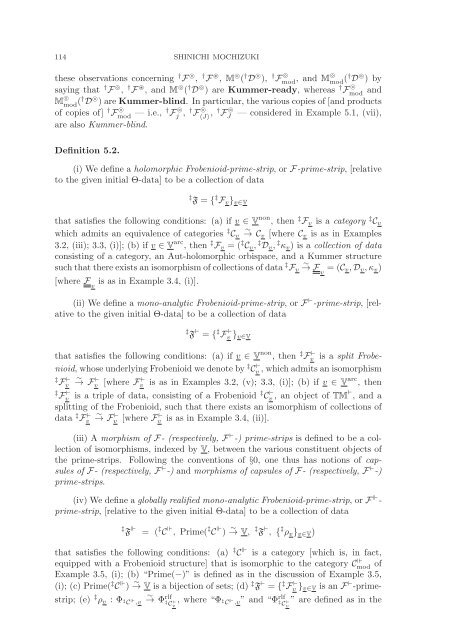Inter-universal Teichmuller Theory I: Construction of Hodge Theaters
Inter-universal Teichmuller Theory I: Construction of Hodge Theaters
Inter-universal Teichmuller Theory I: Construction of Hodge Theaters
You also want an ePaper? Increase the reach of your titles
YUMPU automatically turns print PDFs into web optimized ePapers that Google loves.
114 SHINICHI MOCHIZUKI<br />
these observations concerning † F ⊚ , † F ⊛ , M ⊚ ( † D ⊚ ), † F ⊚ mod ,andM⊚ mod († D ⊚ )by<br />
saying that † F ⊚ , † F ⊛ ,andM ⊚ ( † D ⊚ )areKummer-ready, whereas † F ⊚ mod and<br />
M ⊚ mod († D ⊚ )areKummer-blind. In particular, the various copies <strong>of</strong> [and products<br />
<strong>of</strong> copies <strong>of</strong>] † F ⊚ mod — i.e., † F ⊚ j , † F ⊚ 〈J〉 , † F ⊚ J<br />
— considered in Example 5.1, (vii),<br />
are also Kummer-blind.<br />
Definition 5.2.<br />
(i) We define a holomorphic Frobenioid-prime-strip, orF-prime-strip, [relative<br />
to the given initial Θ-data] to be a collection <strong>of</strong> data<br />
‡ F = { ‡ F v } v∈V<br />
that satisfies the following conditions: (a) if v ∈ V non ,then ‡ F v is a category ‡ C v<br />
which admits an equivalence <strong>of</strong> categories ‡ ∼<br />
C v →Cv [where C v is as in Examples<br />
3.2, (iii); 3.3, (i)]; (b) if v ∈ V arc ,then ‡ F v =( ‡ C v , ‡ D v , ‡ κ v )isacollection <strong>of</strong> data<br />
consisting <strong>of</strong> a category, an Aut-holomorphic orbispace, and a Kummer structure<br />
such that there exists an isomorphism <strong>of</strong> collections <strong>of</strong> data ‡ ∼<br />
F v →Fv =(C v , D v ,κ v )<br />
[where F v<br />
is as in Example 3.4, (i)].<br />
(ii) We define a mono-analytic Frobenioid-prime-strip, orF ⊢ -prime-strip, [relative<br />
to the given initial Θ-data] to be a collection <strong>of</strong> data<br />
‡ F ⊢ = { ‡ F ⊢ v } v∈V<br />
that satisfies the following conditions: (a) if v ∈ V non ,then ‡ Fv<br />
⊢ is a split Frobenioid,<br />
whose underlying Frobenioid we denote by ‡ Cv ⊢ , which admits an isomorphism<br />
∼<br />
→Fv ⊢ [where Fv ⊢ is as in Examples 3.2, (v); 3.3, (i)]; (b) if v ∈ V arc ,then<br />
‡ F ⊢ v<br />
‡ Fv ⊢ is a triple <strong>of</strong> data, consisting <strong>of</strong> a Frobenioid ‡ Cv ⊢ , an object <strong>of</strong> TM ⊢ ,anda<br />
splitting <strong>of</strong> the Frobenioid, such that there exists an isomorphism <strong>of</strong> collections <strong>of</strong><br />
data ‡ Fv<br />
⊢ ∼<br />
→Fv ⊢ [where Fv ⊢ is as in Example 3.4, (ii)].<br />
(iii) A morphism <strong>of</strong> F- (respectively, F ⊢ -) prime-strips is defined to be a collection<br />
<strong>of</strong> isomorphisms, indexed by V, between the various constituent objects <strong>of</strong><br />
the prime-strips. Following the conventions <strong>of</strong> §0, one thus has notions <strong>of</strong> capsules<br />
<strong>of</strong> F- (respectively, F ⊢ -) and morphisms <strong>of</strong> capsules <strong>of</strong> F- (respectively, F ⊢ -)<br />
prime-strips.<br />
(iv) We define a globally realified mono-analytic Frobenioid-prime-strip, orF ⊩ -<br />
prime-strip, [relative to the given initial Θ-data] to be a collection <strong>of</strong> data<br />
‡ F ⊩ = ( ‡ C ⊩ , Prime( ‡ C ⊩ ) ∼ → V, ‡ F ⊢ , { ‡ ρ v } v∈V )<br />
that satisfies the following conditions: (a) ‡ C ⊩ is a category [which is, in fact,<br />
equipped with a Frobenioid structure] that is isomorphic to the category Cmod ⊩ <strong>of</strong><br />
Example 3.5, (i); (b) “Prime(−)” is defined as in the discussion <strong>of</strong> Example 3.5,<br />
(i); (c) Prime( ‡ C ⊩ ) → ∼ V is a bijection <strong>of</strong> sets; (d) ‡ F ⊢ = { ‡ Fv ⊢ } v∈V is an F ⊢ -primestrip;<br />
(e) ‡ ∼<br />
ρ v :Φ‡ C ⊩ ,v → Φ rlf<br />
‡ Cv<br />
⊢,where“Φ‡ C ,v” and“Φ rlf<br />
⊩ ‡ C<br />
” are defined as in the<br />
v ⊢
















